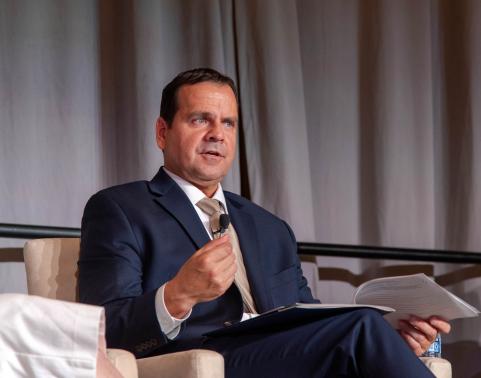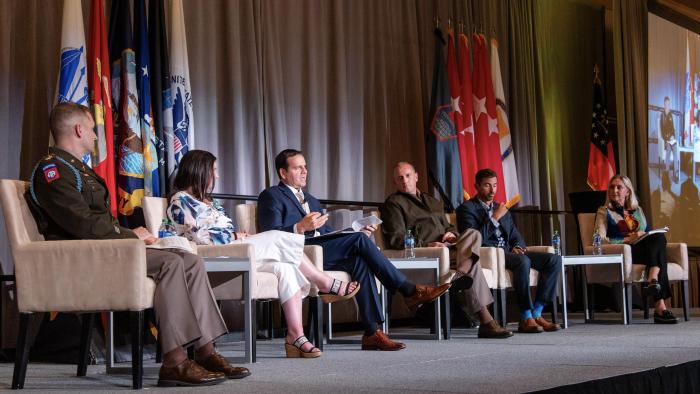Mr. Ross Guckert’s AFCEA TechNet Augusta 2023 Remarks

Ross Guckert’s remarks during the “Joint PEO” panel fireside chat at AFCEA TechNet Augusta on Aug. 15, 2023, are transcribed below. You can watch a video of the entire fireside chat here.
TRANSITION TO AGILE
I am very excited about the progress we are making moving to Agile. Industry is on this ride with us and a key partner. And it's not just pockets of excellence. Across the board, we are seeing signs of the transformation to Agile taking effect. We have been holding monthly offsites with my leadership — we are looking at everything from contracting, establishing a Lean Agile Center of Excellence (LACE) within the headquarters, cost estimating, upskilling and redefining how we use and define our tech services.
The Assistant Secretary of the Army (Acquisition, Logistics and Technology) team has been phenomenal, as Ms. Swanson mentioned, in a number of these areas. We are leveraging what she's doing and what Ms. Dake is doing. And Mr. Bang has been an excellent visionary for us leading the way.
TECHNICAL REVIEWS
We are going to start doing robust technical reviews to ensure that we have an open, modular, modern architecture; stable code; stable and high-quality data; and deliver cyber tools to keep up with emerging threats. Our system integrators, tech services and original equipment manufacturers will help us do these reviews.
CONTRACTING
We are very excited about the Digital Contracting Center of Excellence that is being stood up at Aberdeen Proving Ground under Danielle Moyer. It will define what an Agile contracting package looks like, including contract deliverables and payment structures. It will make sure we are paying for value in the delivery of capability and leverage modular contracting. Danielle is developing Agile playbooks, and we are supporting that effort, that will be used across the Army Contracting Command enterprise.
We are looking at acquisition impacts. We know that the current lead times for some contracts are untenable. Danielle is looking at how we apply Agile to the acquisition lead times. We have been using other-transaction agreements and prototyping very effectively within our portfolio and will continue to use them with future contracts.
UPSKILLING
Upskilling has been very important in our portfolio. The program managers (PMs) have been getting Agile training, whether it's through the Udemy training or individual-focused training within our individual Program Management Offices. Ultimately, we are defining what the training is for every position within our portfolio and letting our folks take that training at their own pace.
ORGANIZED AROUND AGILE
Every PM in EIS is organized around Agile and integrated with the system integrator, the tech services and the functionals. It's really a new standard across EIS, and we are grateful for industry and how they are helping us populate those teams.
We added new leaders. Bill Hepworth, our deputy PEO, has been on board for seven months. Mike Chappell is our new CIO. Rob Schadey, our new assistant PEO, just came back from Senior Service College. And Aric Sherwood is going to head up our LACE at the headquarters.
TECH SERVICES
I mentioned we are redefining our expectations for tech services, critical architecture and code stability. We are ensuring that we have the right metrics, use data science and data analytics to see trends, and leverage new tools with real-time data sources to do our reviews.
In the absence of having a system integrator on board — we are jumping in and starting to burn down that initial backlog while we potentially do a competition for a system integrator. This is very powerful support for our program managers.
SUCCESS STORIES
We have a lot of success stories.
- The Army Contract Writing System put out our first minimum viable product (MVP) last month.
- ArmyIgnitED’s full operational capability will be achieved this month.
- We will release an Accessions Information Environment MVP next month.
- Enterprise Business Systems — Convergence (EBS-C) prototype agreements were awarded today.
- We are taking an innovative approach to Integrated Personnel and Pay System – Army (IPPS-A) and its future capabilities.
- Enterprise-Identity, Credential and Access Management (E-ICAM) onboarding occurs later this year.
- Army Training Information Systems is delivering an initial capability early next year.
- And we're kicking off the Foreign Military Sales – Army Case Execution System program with a software-acquisition pathway. And that's been my default across the portfolio: start with the software-acquisition pathway, and even in cases where we are leveraging 5000.75, we are pivoting to the software-acquisition pathway.
I have said that by December, we will look like a completely different organization, and things are certainly shaping up to look that way.
CULTURAL BARRIERS
With any transformation, culture is going to fight you. If you can show, though, example after example of successes of what the transformation is doing to the portfolio, people really start to buy in.
It’s really powerful when you finally push IPPS-A Release 3 out the door.
It's really powerful when you finally deploy a new contract writing system in the Army.
It's really powerful when you inherit a failed software program and achieve Full Operational Capability within one year.
And it's really powerful when the Army has a recruiting crisis, and we restructure our program and deliver an MVP in a matter of months.
I have been impressed with how this organization has taken Agile and run with it.
We couldn't have done it without our industry partners. We have accelerated through the crawl-and-walk stages, and we are now in the run stage. I am very excited about that.
We have had a record number of team members participate in our lunch-and-learn Agile series and attend training sessions. We have had significant cross-portfolio sharing of lessons learned and best practices.
My leaders and I take every opportunity to talk about our Agile transformation. Our deputy PEO, CIO and assistant PEO bring critical skill sets to the table to implement our transformation, and our STRATCOM team is the best in the business. The message we keep pushing out is really important for that cultural change.
EDUCATING FUNCTIONALS
One of the barriers I first saw when I got on board was educating our functionals.
Agile, like Ms. Swanson said, starts with an Agile-written requirement that we can decouple and field in increments.
It starts with business process reengineering around commercial best practices.
It starts with an initial prioritized backlog, assigned to Scrum teams, executing human-centered design, always reprioritizing the backlog, getting into that cadence defining the definition of “done,” and executing a robust organizational change-management (OCM) program.
Under OCM, before we deploy a system, there are roadshows, training, and strategic communications. So when it does finally get pushed out, the user knows what to expect, is excited about it, and understands the value that it brings.
And now, our functionals are fully on board. They have really stepped up at different levels of maturity, but we are on a great trajectory to get our functionals on board for Agile.
COLOR OF MONEY
A final barrier that we continue to see is the color of money. We have one budget activity pilot in Defensive Cyber Operations, but we are looking to spread it across many more software programs.
At any point in time, I can be doing development, buying licenses or doing continuous modernization — three different colors of money. So two years out, I can't predict what that looks like and how that plays out. Having a colorless appropriation gives me flexibility so I don't have to wait for a Below Threshold Reprogramming or an Above Threshold Reprogramming to process it. It really allows me to do that immediately and, at the end of the day, respond to the threat.
PARTNERSHIP WITH INDUSTRY
If you know me, you know the importance I place on our partnership with industry. We don't put out a request for proposals until it's been put out in draft form many times, have an Industry Day and one-on-one discussions. And we use that input to inform our strategies.
As we go on this transformational journey, we expect industry to be on board, to organize around Agile, to show us their best practices and share their thoughts on what the best contracting strategy is. Industry is a key partner in our Agile journey.
Better quality product, faster: that's what Agile does. And that's what we've proven time and again. We are really excited about this transformational journey we are on and our partnership with industry.
DATA GOVERNANCE
Mr. Bang touched on the unstructured, structured data piece in his remarksearlier today. It’s about the governance piece. There are going to be data owners and data stewards.
I don’t like to use the word “standard,” but there is going to be something that needs to be complied with to put data products into the service catalog. And after the Army pushes out an E-ICAM solution that authenticates role-based and attribute-based access, whoever comes into the network has access to what they need and doesn't get access to what they don't need.
INDUSTRY ENGAGEMENT
It’s a collective effort. It's not just the PEO’s or PM’s role to help influence industry’s Independent Research and Development. The functionals who are writing requirements have an idea of what's coming down the pike. Where are the gaps that they are writing the requirements against? Today, there are a lot of implied requirements (robotic process automations, artificial intelligence and machine learning) that we look for as we implement EBS-C, for instance. What kind of tools can we use that are going to help us streamline that process and put 21st century solutions in the battlefield?
AQUISITION POLICY BLOCKERS TO MOVING TO AGILE
Sometimes we are our worst enemy. We don't take advantage of the authorities we already have. The software-acquisition pathway is a great example — it allows us to move very fast in an Agile fashion. But two things that stick out to me are (1) continuous Authorization to Operate (ATO) — getting that completed and on the books so we can don't have to continue to go back and ask for an ATO and (2) the color of money for software development. I know ASA(ALT) is all over that to generate more pilots. That will give us a lot more latitude as well.
Work for Us
Join a winning team! Search for job opportunities with PEO Enterprise.
Work with Us
Help support important missions. Explore ways your company can work with PEO Enterprise.
